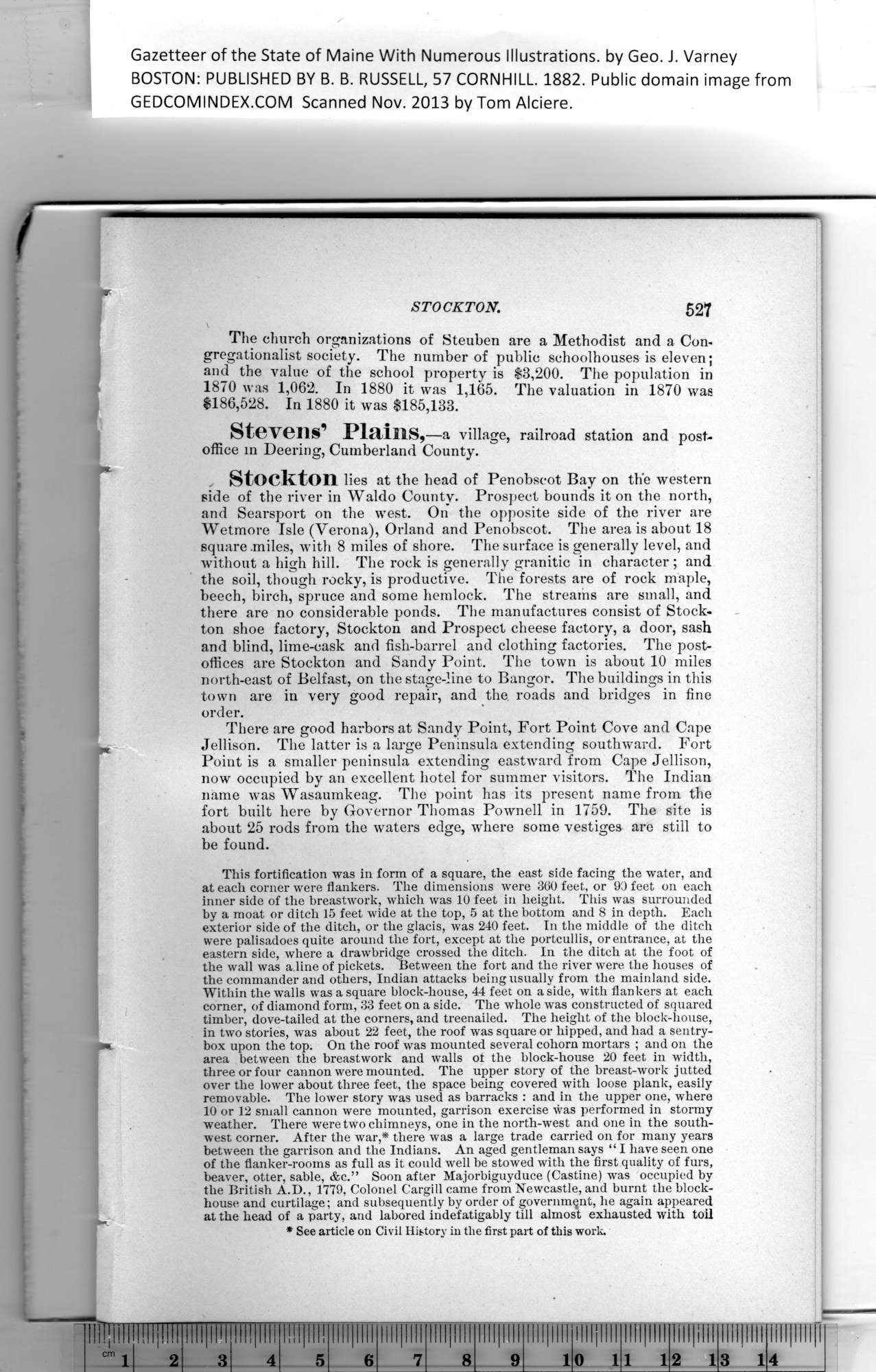|
Gazetteer of the State of Maine With Numerous Illustrations, by Geo. J. Varney
BOSTON: PUBLISHED BY B. B. RUSSELL, 57 CORNHILL. 1882. Public domain image from
STOCKTON 527
The church organizations of Steuben are a Methodist and a Con-
gregationalist society. The number of public schoolhouses is eleven;
and the value of the school property is $3,200. The population in
1870 was 1,062. In 1880 it was 1,165. The valuation in 1870 was
$186,528. In 1880 it was $185,133.
Stevens’ Plains,—a village, railroad station and post-
office in Deering, Cumberland County.
Stockton lies at the head of Penobscot Bay on the western
side of the river in Waldo County. Prospect bounds it on the north,
and Searsport on the west. On the opposite side of the river are
Wetmore Isle (Verona), Orland and Penobscot. The area is about 18
square .miles, with 8 miles of shore. The surface is generally level, and
without a high hill. The rock is generally granitic in character ; and
the soil, though rocky, is productive. The forests are of rock maple,
beech, birch, spruce and some hemlock. The streams are small, and
there are no considerable ponds. The manufactures consist of Stock-
ton shoe factory, Stockton and Prospect cheese factory, a door, sash
and blind, lime-cask and fish-barrel and clothing factories. The post-
offices are Stockton and Sandy Point. The town is about 10 miles
north-east of Belfast, on the stage-line to Bangor. The buildings in this
town are in very good repair, and the. roads and bridges in fine
order.
There are good harbors at Sandy Point, Fort Point Cove and Cape
Jellison. The latter is a large Peninsula extending southward. Fort
Point is a smaller peninsula extending eastward from Cape Jellison,
now occupied by an excellent hotel for summer visitors. The Indian
name was Wasaumkeag. The point lias its present name from the
fort built here by Governor Thomas Pownell in 1759. The site is
about 25 rods from the waters edge, where some vestiges are still to
be found.
This fortification was in form of a square, the east side facing the water, and
at each corner were flankers. The dimensions were 360 feet, or 90 feet on each
inner side of the breastwork, which was 10 feet in height. This was surrounded
by a moat or ditch 15 feet wide at the top, 5 at the bottom and 8 in depth. Each
exterior side of the ditch, or the glacis, was 240 feet. In the middle of the ditch
were palisadoes quite around the fort, except at the portcullis, or entrance, at the
eastern side, where a drawbridge crossed the ditch. In the ditch at the foot of
the wall was a line of pickets. Between the fort and the river were the houses of
the commander and others, Indian attacks being usually from the mainland side.
Within the walls was a square block-house, 44 feet on a side, with flankers at each
corner, of diamond form, 33 feet on a side. The whole was constructed of squared
timber, dove-tailed at the corners, and treenailed. The height of the hlock-liouse,
in two stories, was about 22 feet, the roof was square or hipped, and had a sentry-
box upon the top. On the roof was mounted several cohorn mortars ; and on the
area between the breastwork and walls ot the block-house 20 feet in width,
three or four cannon were mounted. The upper story of the breast-work jutted
over the lower about three feet, the space being covered with loose plank, easily
removable. The lower story was used as barracks : and in the upper one, where
10 or 12 small cannon were mounted, garrison exercise was performed in stormy
weather. There were two chimneys, one in the north-west and one in the south-
west corner. After the war,* there was a large trade carried on for many years
between the garrison and the Indians. An aged gentleman says “ I have seen one
of the flanker-rooms as full as it could well be stowed with the first quality of furs,
beaver, otter, sable, &c.” Soon after Majorbiguyduce (Castine) was occupied by
the British A.D., 1779, Colonel Cargill came from Newcastle, and burnt the block-
house and curtilage; and subsequently by order of government, he again appeared
at the head of a party, and labored indefatigably till almost exhausted with toil
* See article on Civil History in the first part of this work.
PREVIOUS PAGE ... NEXT PAGE
This page was written in HTML using a program written in Python 3.2
|
